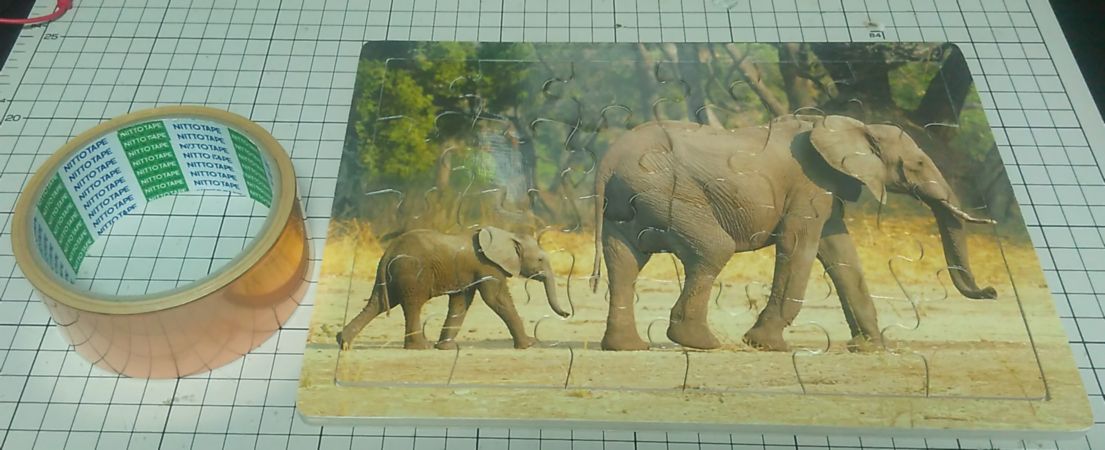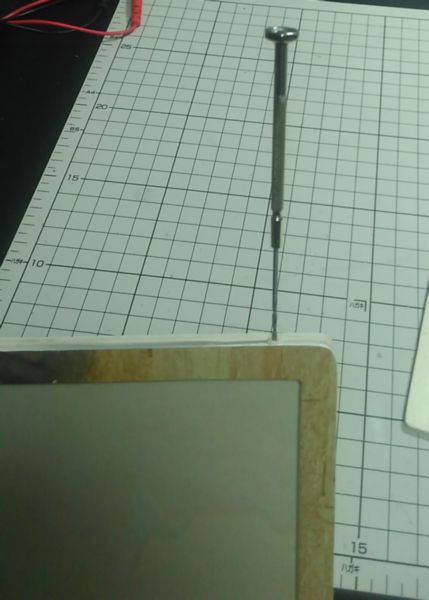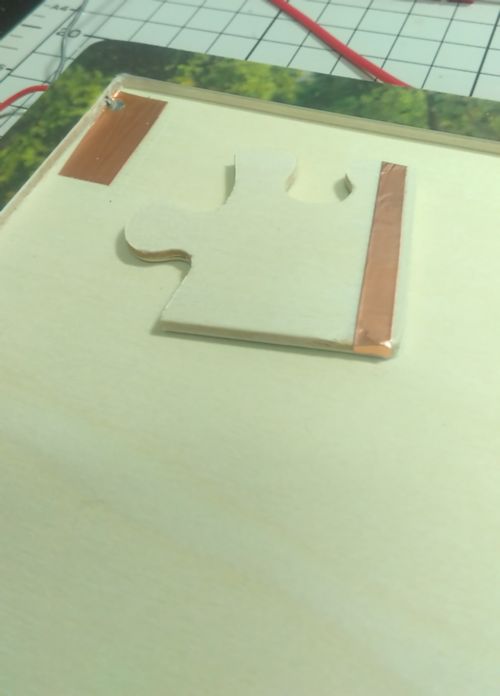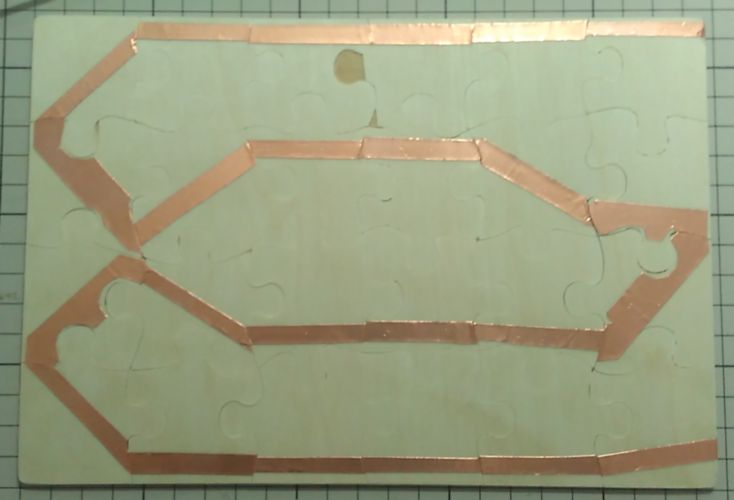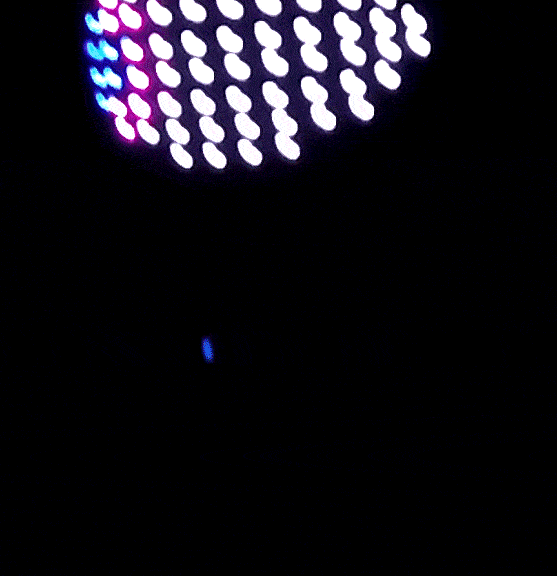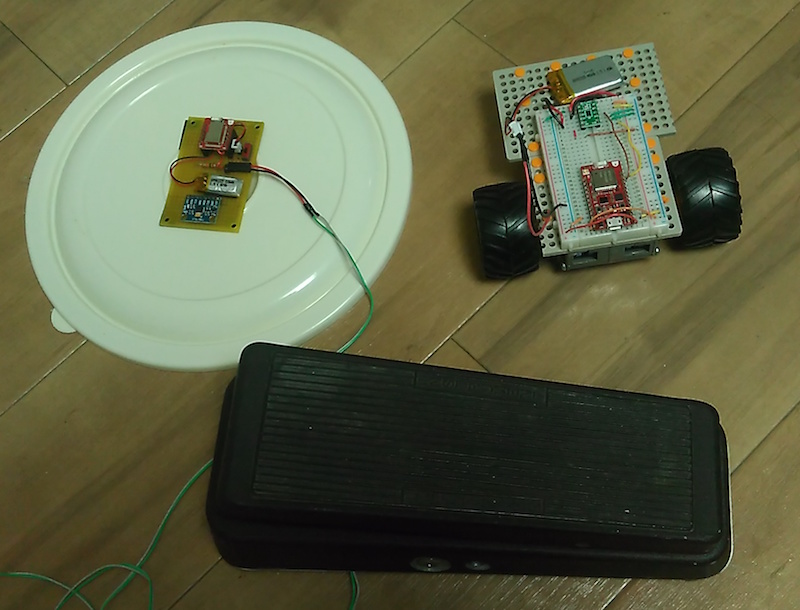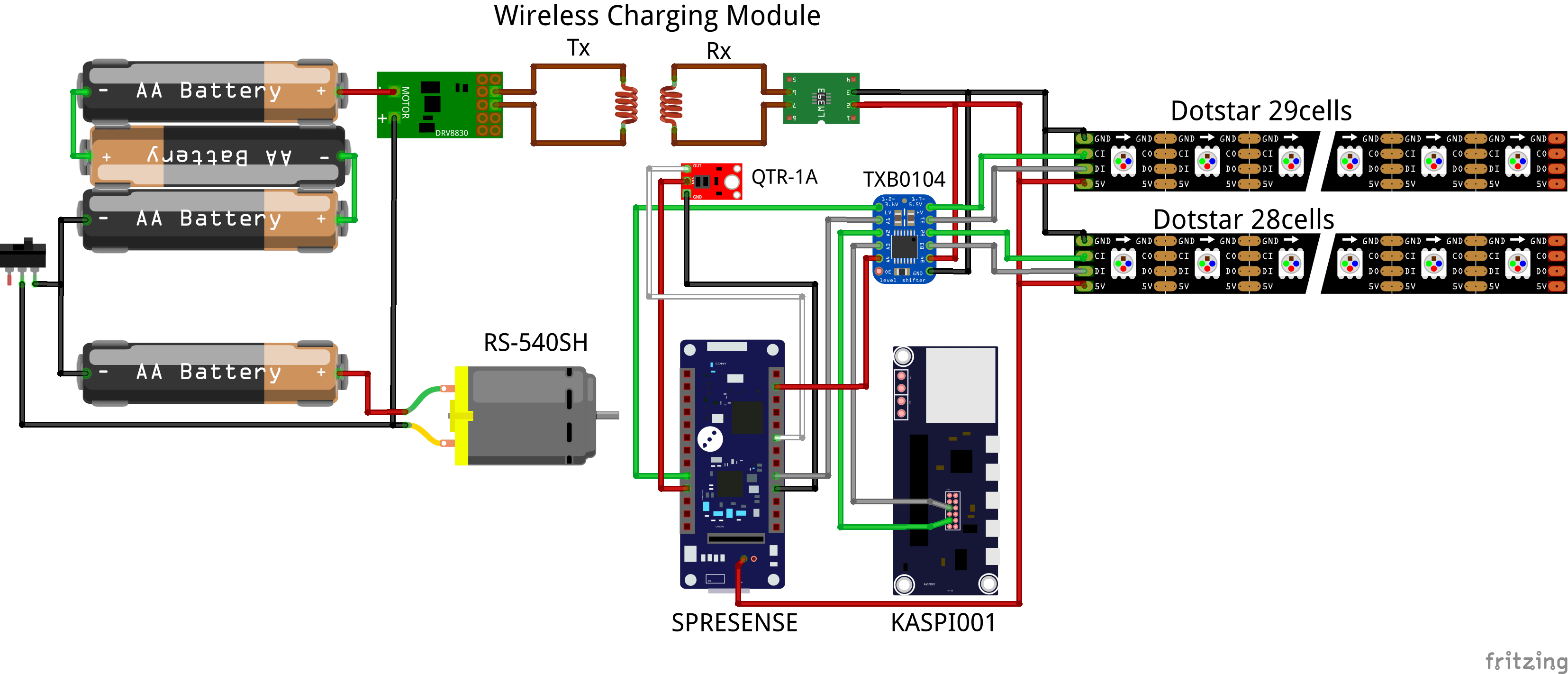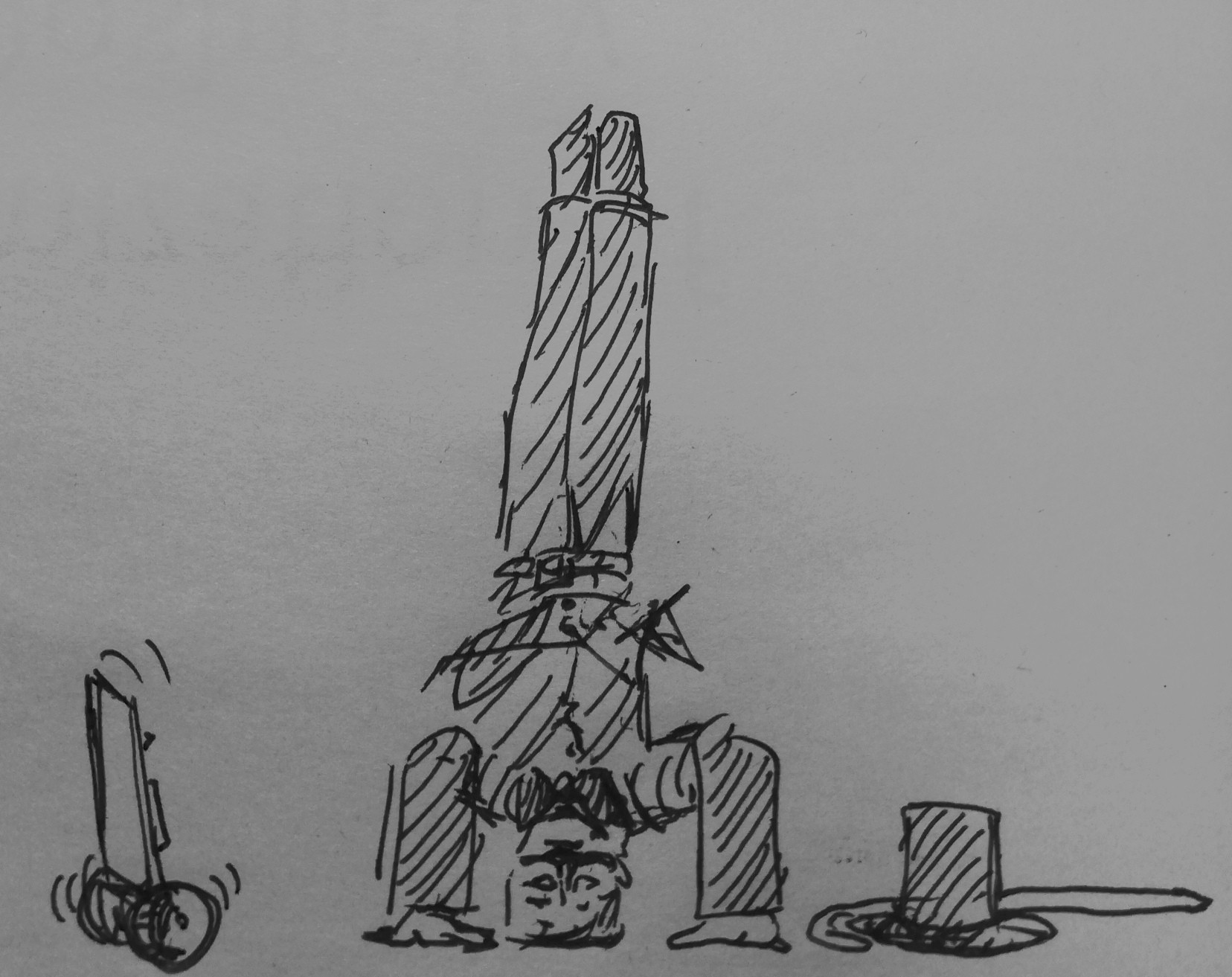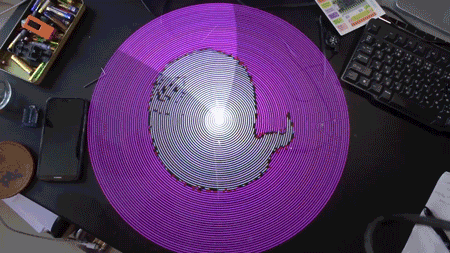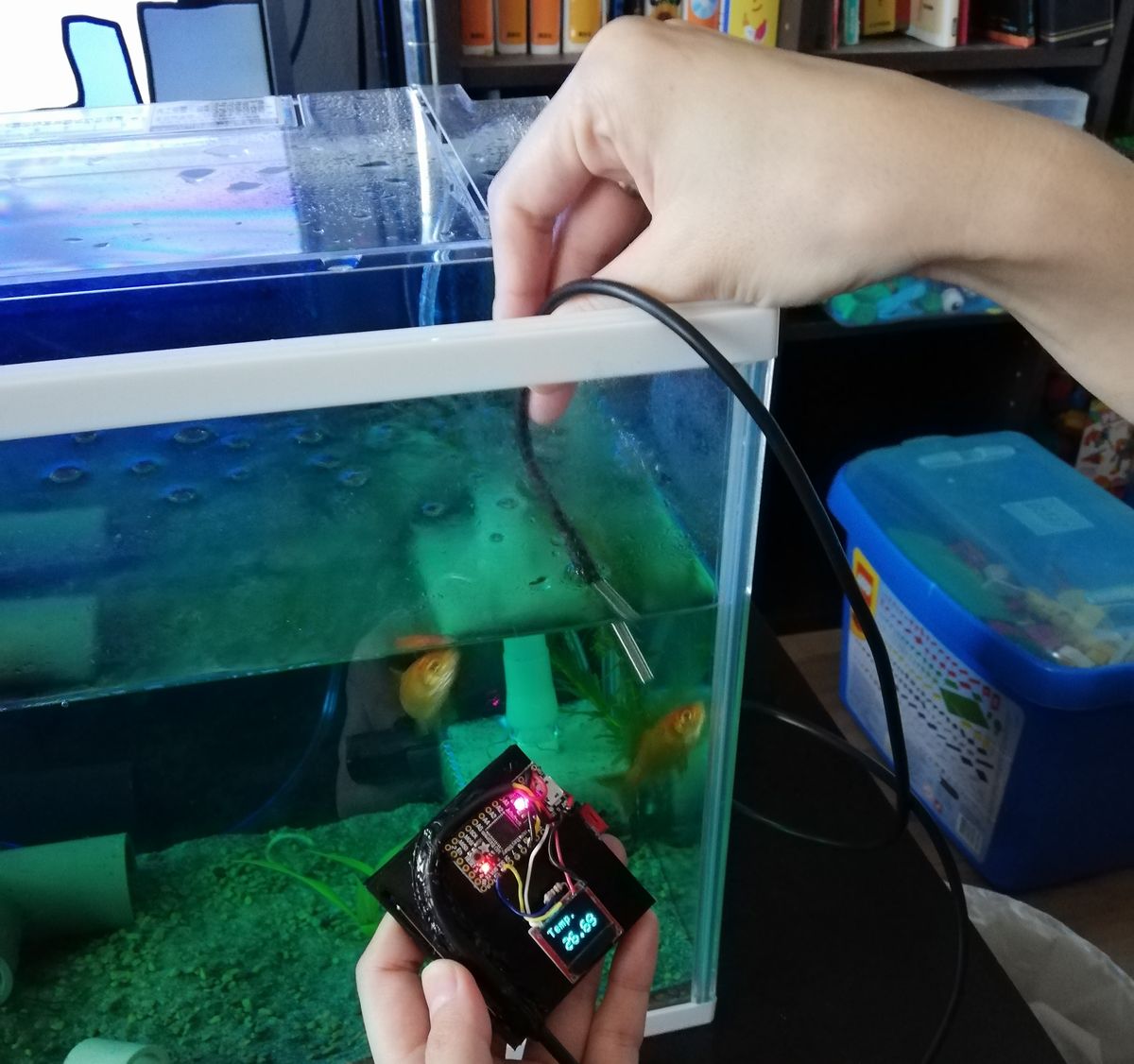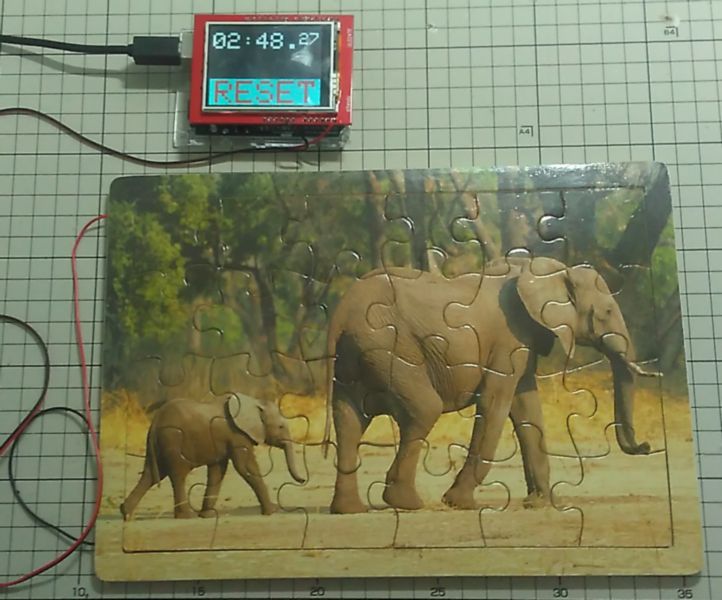
できあがるまでの時間を測定 ~ パズル・タイマー ~
本記事にはアフィリエイト広告が含まれます。
子どもたちがパズルを競うようにしてやってるのをみて、タイマーつけてみよう(・∀・)と思い立ちました。
パズルが完成するとタイマーが止まりできあがるまでの時間を測定します。
目次
構成

Arduino UNO用タッチスクリーンディスプレイシールドを用いて時間表示し、パズルの裏面には導電テープを張って完成すると通電してタイマーを止める仕組みとなっております。
部品
-
マイコン Arduino UNO
-
タッチスクリーン液晶ディスプレイシールド UL024TF
-
ダイソーの木製パズル
-
銅箔テープ
パズル加工
木製パズルの裏面に銅箔テープをつけて完成すると導通するように加工します。
タッチスクリーン液晶ディスプレイ
地元の部品屋さんで安く手に入れたものです。面白い(^o^)。Arduino UNOに挿して使用します。
めっちゃいい買い物した!#arduino #タッチパネル #梅澤無線https://t.co/RWGpKrQ7B5 https://t.co/M9FbXHbGb9
— HomeMadeGarbage (@H0meMadeGarbage) 2016年9月5日
パズル完成までの時間を測るストップウォッチとして使用しました。
Arduino IDEプログラム
以下のArduino用ライブラリを使用します。
https://github.com/adafruit/TFTLCD-Library
https://github.com/adafruit/Adafruit-GFX-Library
プログラム例のtftpaint.inoをベースにプログラム作成しました。
https://github.com/adafruit/TFTLCD-Library/blob/master/examples/tftpaint/tftpaint.ino
ディスプレイシールドをUNOに挿してパズルの2極の配線を一方をA5ピン、他方をGNDに接続します。タッチパネルの”START”を押すとタイマーが開始して、パズルが完成してA5がGNDに導通することでストップウォッチがストップします。
|
1 2 3 4 5 6 7 8 9 10 11 12 13 14 15 16 17 18 19 20 21 22 23 24 25 26 27 28 29 30 31 32 33 34 35 36 37 38 39 40 41 42 43 44 45 46 47 48 49 50 51 52 53 54 55 56 57 58 59 60 61 62 63 64 65 66 67 68 69 70 71 72 73 74 75 76 77 78 79 80 81 82 83 84 85 86 87 88 89 90 91 92 93 94 95 96 97 98 99 100 101 102 103 104 105 106 107 108 109 110 111 112 113 114 115 116 117 118 119 120 121 122 123 124 125 126 127 128 129 130 131 132 133 134 135 136 137 138 139 140 141 142 143 144 145 146 147 148 149 150 151 152 153 154 155 156 157 158 159 160 161 162 163 164 165 166 167 168 169 170 171 172 173 174 175 176 177 178 179 180 181 182 183 184 185 186 187 188 189 190 191 192 193 194 195 196 197 198 |
#include <Adafruit_GFX.h> // Core graphics library #include <Adafruit_TFTLCD.h> // Hardware-specific library #include <TouchScreen.h> #if defined(__SAM3X8E__) #undef __FlashStringHelper::F(string_literal) #define F(string_literal) string_literal #endif #define YP A1 // must be an analog pin, use "An" notation! #define XM A2 // must be an analog pin, use "An" notation! #define YM 7 // can be a digital pin #define XP 6 // can be a digital pin #define TS_MINX 150 #define TS_MINY 120 #define TS_MAXX 920 #define TS_MAXY 940 // For better pressure precision, we need to know the resistance // between X+ and X- Use any multimeter to read it // For the one we're using, its 300 ohms across the X plate TouchScreen ts = TouchScreen(XP, YP, XM, YM, 300); #define LCD_CS A3 #define LCD_CD A2 #define LCD_WR A1 #define LCD_RD A0 // optional #define LCD_RESET A4 // Assign human-readable names to some common 16-bit color values: #define BLACK 0x0000 #define BLUE 0x001F #define RED 0xF800 #define GREEN 0x07E0 #define CYAN 0x07FF #define MAGENTA 0xF81F #define YELLOW 0xFFE0 #define WHITE 0xFFFF Adafruit_TFTLCD tft(LCD_CS, LCD_CD, LCD_WR, LCD_RD, LCD_RESET); long startTime; long elapsedTime; int fractional = 0; int Min = 0; int sec = 0; int state = 3; void setup(void) { Serial.begin(9600); Serial.println(F("Paint!")); pinMode(A5, INPUT_PULLUP); tft.reset(); uint16_t identifier = tft.readID(); if(identifier == 0x9325) { Serial.println(F("Found ILI9325 LCD driver")); } else if(identifier == 0x9328) { Serial.println(F("Found ILI9328 LCD driver")); } else if(identifier == 0x7575) { Serial.println(F("Found HX8347G LCD driver")); } else if(identifier == 0x9341) { Serial.println(F("Found ILI9341 LCD driver")); } else if(identifier == 0x8357) { Serial.println(F("Found HX8357D LCD driver")); } else { Serial.print(F("Unknown LCD driver chip: ")); Serial.println(identifier, HEX); Serial.println(F("If using the Adafruit 2.8\" TFT Arduino shield, the line:")); Serial.println(F(" #define USE_ADAFRUIT_SHIELD_PINOUT")); Serial.println(F("should appear in the library header (Adafruit_TFT.h).")); Serial.println(F("If using the breakout board, it should NOT be #defined!")); Serial.println(F("Also if using the breakout, double-check that all wiring")); Serial.println(F("matches the tutorial.")); return; } tft.begin(identifier); tft.fillScreen(BLACK); tft.setRotation(1); tft.fillRect(0, 160, tft.width(), 80, CYAN); tft.setCursor(15, 165); tft.setTextColor(RED); tft.setTextSize(10); tft.println("START"); } #define MINPRESSURE 10 #define MAXPRESSURE 1000 void loop() { TSPoint p = ts.getPoint(); // if sharing pins, you'll need to fix the directions of the touchscreen pins //pinMode(XP, OUTPUT); pinMode(XM, OUTPUT); pinMode(YP, OUTPUT); //pinMode(YM, OUTPUT); // we have some minimum pressure we consider 'valid' // pressure of 0 means no pressing! if (p.z > MINPRESSURE && p.z < MAXPRESSURE) { /* Serial.print("X = "); Serial.print(p.x); Serial.print("\tY = "); Serial.print(p.y); Serial.print("\tPressure = "); Serial.println(p.z); */ // scale from 0->1023 to tft.width p.x = map(p.x, TS_MINX, TS_MAXX, tft.width(), 0); p.y = map(p.y, TS_MINY, TS_MAXY, tft.height(), 0); Serial.print("("); Serial.print(p.x); Serial.print(", "); Serial.print(p.y); Serial.println(")"); if (p.x > 160 && digitalRead(A5) == 1) { Serial.println("リセット"); if(state == 1){ state = 2; tft.fillRect(0, 160, tft.width(), 80, CYAN); tft.setCursor(15, 165); tft.setTextColor(RED); tft.setTextSize(10); tft.println("RESET"); }else if(state == 2) { elapsedTime = 0; state = 3; tft.fillRect(0, 160, tft.width(), 80, CYAN); tft.setCursor(15, 165); tft.setTextColor(RED); tft.setTextSize(10); tft.println("START"); }else{ state = 0; } delay(100); } } if(state == 0){ startTime = millis(); state = 1; tft.fillRect(0, 160, tft.width(), 80, CYAN); tft.setCursor(45, 165); tft.setTextColor(RED); tft.setTextSize(10); tft.println("STOP"); }else if(state == 1){ elapsedTime = millis() - startTime; } if(digitalRead(A5) == 0 && state != 3 && state != 2){ state = 2; tft.fillRect(0, 160, tft.width(), 80, CYAN); tft.setCursor(15, 165); tft.setTextColor(RED); tft.setTextSize(10); tft.println("RESET"); } tft.setCursor(5, 15); tft.setTextColor(WHITE, BLACK); tft.setTextSize(7); Min = (int)((elapsedTime / 1000L)/60); if (Min < 10) tft.print("0"); tft.print(Min); tft.print(":"); sec = (int)((elapsedTime / 1000L) % 60); if (sec < 10) tft.print("0"); tft.print(sec); tft.print("."); tft.setTextSize(5); fractional = (int)((elapsedTime % 1000L)/10); if (fractional < 10) tft.print("0"); tft.println(fractional); } |
動作
 お父ちゃん
2017.5.5
お父ちゃん
2017.5.5
